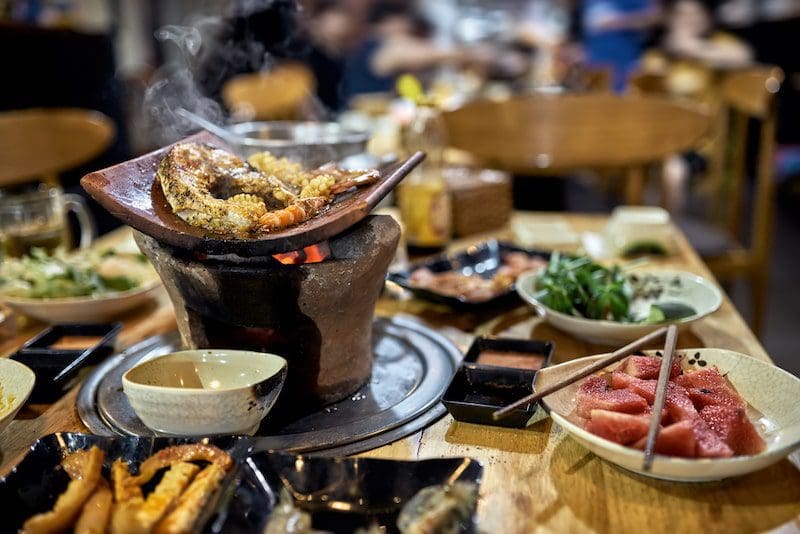Are you a food enthusiast searching for your next culinary adventure? Look no further than the Vietnamese food from the Quang Nam Province.
Vietnam is known for its vibrant and flavorful cuisine, but the dishes from Quang Nam and Hoi An stand out as some of the best food in Vietnam.
In this article, we’ll explore the unique flavors and rich history of this region’s food culture and provide tips on how to make the most of your culinary journey.
Where is the Quang Nam Province?
Located in central Vietnam, the Quang Nam Province is a treasure box of cultural and culinary delights. The ancient town of Hoi An, a UNESCO World Heritage Site, lies within this province and is a must-visit destination for anyone traveling to Vietnam.
What is the Quang Nam Province Famous For?

The Quang Nam Province is known for its rich cultural heritage, stunning natural beauty, and vibrant culinary scene. Here are some of the most famous aspects of the Quang Nam Province that make it a must-visit destination for travelers:
Hoi An Ancient Town
The historic town of Hoi An, a UNESCO World Heritage Site, is undoubtedly one of Quang Nam’s most famous attractions. With its well-preserved architecture, colorful lanterns, and charming streets, Hoi An offers a glimpse into Vietnam’s past and a unique cultural experience for visitors.
My Son Sanctuary
Another UNESCO World Heritage Site in Quang Nam, My Son Sanctuary is a complex of ancient Hindu temples built by the Champa Kingdom between the 4th and 13th centuries. The site is an impressive example of Champa architecture and is considered one of the most important archaeological sites in Southeast Asia.
Cham Island
Just off the coast of Hoi An, Cham Island is a popular destination for its pristine beaches, crystal-clear waters, and vibrant marine life. The island is an excellent spot for snorkeling, diving, or simply relaxing on the beach.
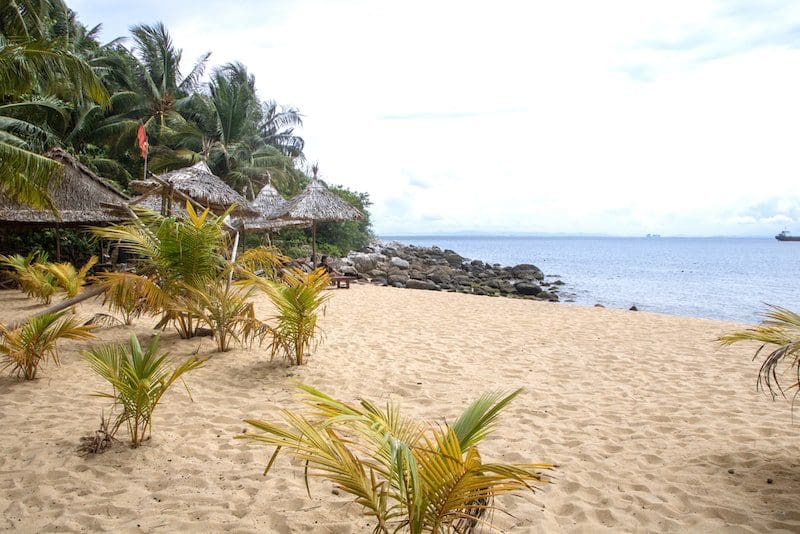
Culinary Scene
Quang Nam Province is famous for its diverse and flavorful cuisine, with dishes such as Cao Lau, Mi Quang, and Com Ga topping the list of must-try foods. The region’s culinary offerings are a reflection of its unique history, cultural influences, and abundant natural resources.
Silk Production
Quang Nam Province has a long history of silk production, dating back to the days of the Champa Kingdom. Today, visitors can explore silk villages, such as the Ma Chau Silk Village, to learn about traditional silk-making techniques and even purchase handcrafted silk products as souvenirs. Additionally, Hoi An is a great destination for getting some tailored outfits at a very good price.
Traditional Crafts
Quang Nam is also famous for its traditional crafts, such as pottery, wood carving, and lantern making. The Thanh Ha Pottery Village and Kim Bong Carpentry Village are excellent examples of local craftsmanship that has been preserved for generations.
The Unique Food Culture of Quang Nam
The food from Quang Nam Province is characterized by its simplicity, fresh ingredients, and distinct flavors. This region’s cuisine is heavily influenced by its coastal location, with an abundance of seafood and locally grown produce. Additionally, Hoi An’s history as a trading port has resulted in a fusion of flavors and cooking techniques from various cultures.
What Makes Vietnamese Food Special?
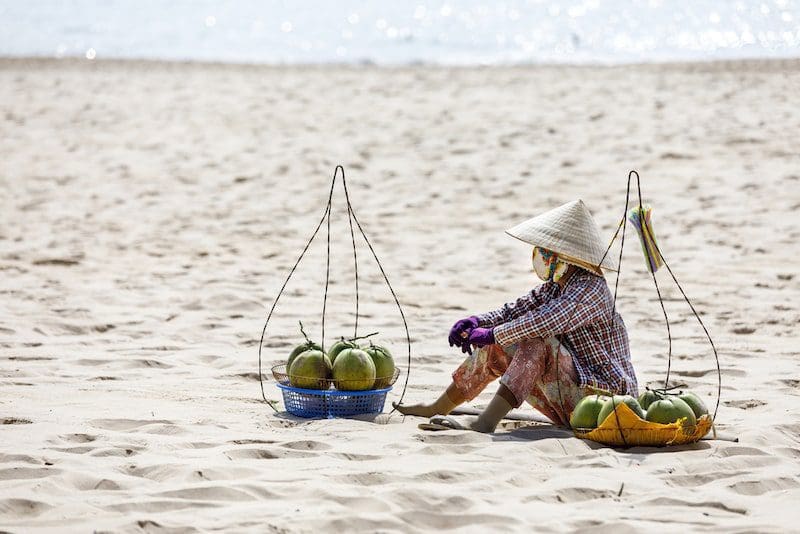
Fresh Ingredients and Bold Flavors
Vietnamese food is celebrated for its use of fresh ingredients, such as herbs, vegetables, and spices. The combination of sweet, sour, salty, and spicy flavors creates a harmonious and satisfying taste that leaves diners craving more.
Balanced and Nutritious Cuisine
Vietnamese cuisine is not only delicious but also balanced and nutritious. Meals typically consist of rice or noodles, protein, and an array of vegetables, providing a well-rounded and wholesome dining experience.
Versatility and Regional Differences
One of the most remarkable aspects of Vietnamese food is its regional diversity. While some dishes are popular nationwide, each region boasts its unique specialties and flavors that reflect the local geography and culture.
A Brief History of Food from the Quang Nam Province
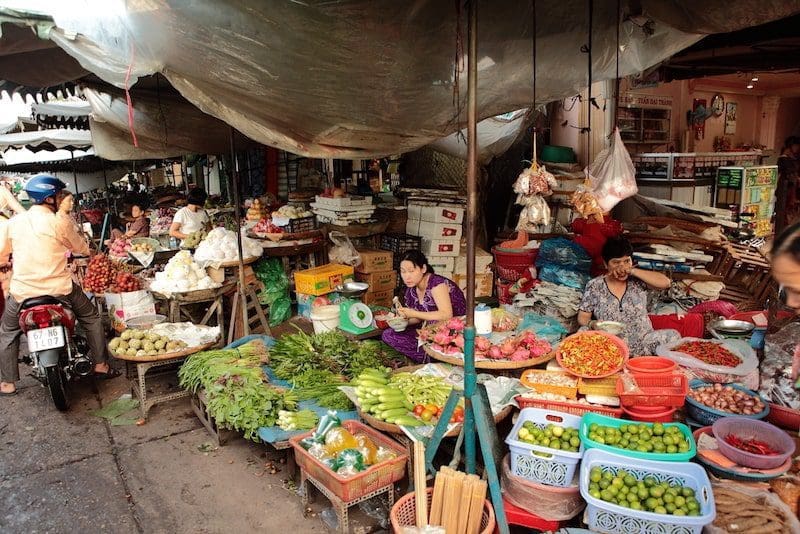
Ancient Influences and Cultural Fusion
The history of Vietnamese food in the Quang Nam Province can be traced back to ancient times. Influences from the Champa Kingdom, China, and later, European traders, have shaped the region’s culinary landscape. These foreign culinary elements have been integrated into the local food culture, resulting in a fusion of flavors and cooking techniques that can still be tasted today.
The Role of Hoi An in Shaping the Local Cuisine
As a thriving trading port during the 16th and 17th centuries, Hoi An played a significant role in the development of Quang Nam’s food culture. The exchange of goods and ideas with traders from Japan, China, and Europe introduced new ingredients, dishes, and culinary practices to the region, enriching the local cuisine.
Must-Try Dishes in Quang Nam Province
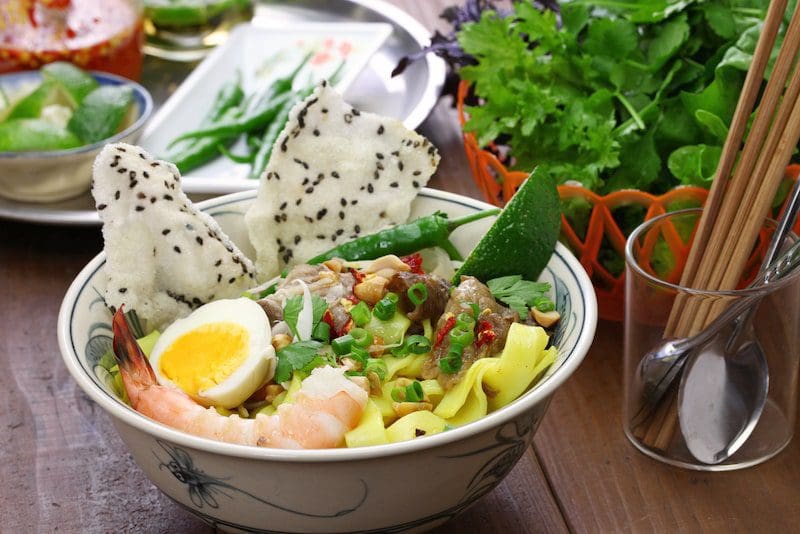
Cao Lau: A Hoi An Specialty
Cao Lau is a unique noodle dish that can only be found in Hoi An. The dish features thick, chewy noodles, slices of tender pork, crispy croutons, fresh herbs, and a savory broth. The secret to Cao Lau’s distinct flavor lies in the water used to make the noodles, which is sourced from a local well.
Mi Quang: A Quintessential Quang Nam Dish
Mi Quang is a beloved noodle dish from the Quang Nam Province. It features wide rice noodles, a rich broth made from pork or chicken, and various toppings such as shrimp, pork, quail eggs, and fresh herbs. A squeeze of lime and a sprinkle of peanuts add the finishing touch to this delicious and satisfying dish.
Banh Beo: Delightful Steamed Rice Cakes
Banh Beo is a popular snack in central Vietnam, consisting of small, steamed rice cakes topped with minced shrimp, crispy pork rinds, and scallions. Served with a tangy fish sauce, these delicate bites are the perfect blend of textures and flavors.
Com Ga: Hoi An’s Famous Chicken Rice
Com Ga, or chicken rice, is a simple yet flavorful dish that has become synonymous with Hoi An. Tender, fragrant rice is cooked with chicken broth and turmeric, then topped with shredded chicken, fresh herbs, and a drizzle of ginger-infused fish sauce. A side of chili sauce adds a spicy kick to this comforting meal.
Banh Xeo: Crispy Vietnamese Pancakes
Banh Xeo is a crispy, savory pancake made from rice flour, turmeric, and coconut milk. Stuffed with a mouthwatering mixture of pork, shrimp, bean sprouts, and fresh herbs, these pancakes are a delicious and interactive dining experience. Enjoy them by wrapping a piece of the pancake in a lettuce leaf, dipping it in fish sauce, and appreciating the burst of flavors.
Exploring Hoi An’s Bustling Food Scene
Street Food and Markets
Venturing through the streets and markets of Hoi An is an essential part of experiencing the local food culture. Sample tasty treats from street vendors, such as Banh Mi sandwiches or sweet desserts like Che, and discover the flavors of Quang Nam at the bustling central market.
Local Restaurants and Cafes
Hoi An’s food scene extends beyond street food, with an array of local restaurants and cafes offering traditional and modern takes on Vietnamese dishes. Whether you’re in the mood for a family-style feast or a contemporary fusion dish, there’s something to satisfy every palate in Hoi An.
Food Festivals and Events
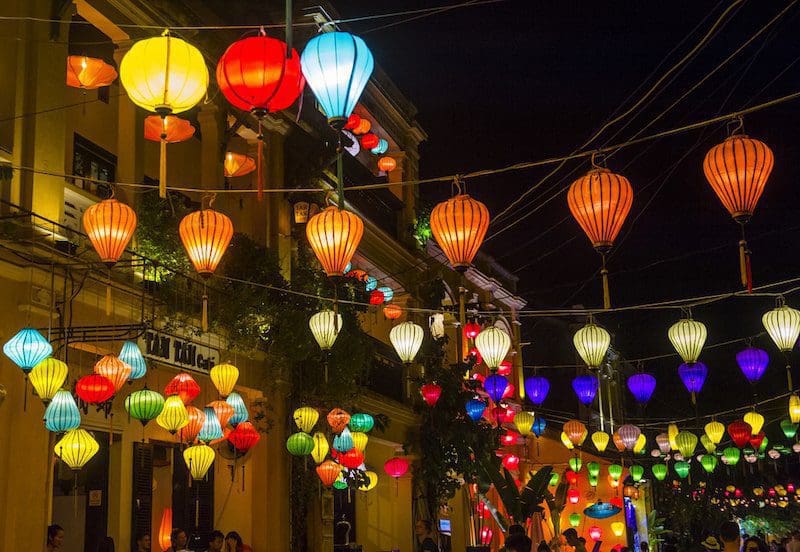
Several food festivals and events are happening in Hoi An throughout the year. Some of the best ones include:
Hoi An International Food Festival
This annual event typically takes place in March and attracts chefs and food enthusiasts from around the world. The festival features cooking demonstrations, food stalls showcasing various international and local cuisines, and exciting culinary competitions.
Hoi An Lantern Festival
Held monthly on the night of the full moon, the Hoi An Lantern Festival is a vibrant celebration of the town’s cultural heritage. While the primary focus of the event is the display of colorful lanterns, the festival also offers a wide array of delicious street food, traditional snacks, and local specialties to enjoy as you wander through the lantern-lit streets.
Tet Nguyen Dan (Vietnamese Lunar New Year)
Celebrated in late January or early February, Tet is the most important festival in Vietnam, and Hoi An is no exception. During Tet, families gather to prepare and share traditional foods, such as Banh Chung (sticky rice cake), and various sweets. The streets of Hoi An are filled with food vendors offering an assortment of festive dishes to mark the occasion.
Mid-Autumn Festival
This annual festival, also known as the Moon Festival, occurs in September or October, depending on the lunar calendar. The event is characterized by the consumption of mooncakes, a traditional Chinese pastry filled with sweet or savory ingredients. In Hoi An, the Mid-Autumn Festival also features lion dances, lantern displays, and an abundance of street food to enjoy.
These food events and festivals provide an excellent opportunity for visitors to experience the unique flavors and culinary traditions of Hoi An, while also taking part in vibrant cultural celebrations.
FAQs about Quang Nam Province’s Food Scene
When is the best time to visit Quang Nam Province?
The best time to visit the Quang Nam Province is during the dry season, which typically runs from February to July. This period offers pleasant weather and plenty of opportunities to explore the local food scene without the hindrance of heavy rainfall.
Are there vegetarian and vegan options in the Quang Nam Province?
Yes, Vietnamese cuisine is generally vegetable-heavy, and many dishes can be easily adapted to accommodate dietary restrictions. Additionally, several vegetarian and vegan-specific restaurants can be found in Hoi An.
How spicy is the Vietnamese food from the Quang Nam Province?
Vietnamese food from the Quang Nam Province tends to be less spicy compared to some other regions in Vietnam. However, many dishes are accompanied by chili sauce or fresh chilies on the side. This allows visitors to adjust the heat level as preferred.
Is it safe to eat street food in Hoi An?
Street food in Hoi An is generally safe to eat, as long as you follow some basic precautions. Look for vendors with a high turnover of customers, which ensures the food is fresh. Also, observe the cleanliness of the vendor and their food preparation area before deciding to eat there.
Are cooking classes available to learn how to make Vietnamese dishes from the Quang Nam Province?
Yes, cooking classes are available in Hoi An for those interested in learning how to prepare local Vietnamese dishes. These classes typically include a visit to a local market to purchase fresh ingredients, followed by hands-on instruction from a skilled chef.
A Flavorful Adventure Awaits in the Quang Nam Province
Embarking on a culinary journey through the Quang Nam Province and Hoi An is a must for any food lover of all ages visiting Vietnam. From the history-steeped dishes to the bustling street food scene, there’s no shortage of delectable experiences awaiting you in this vibrant region. Pack your bags, bring your appetite, and prepare to be captivated by the mouthwatering flavors of Vietnamese food from the incredible Quang Nam Province.


